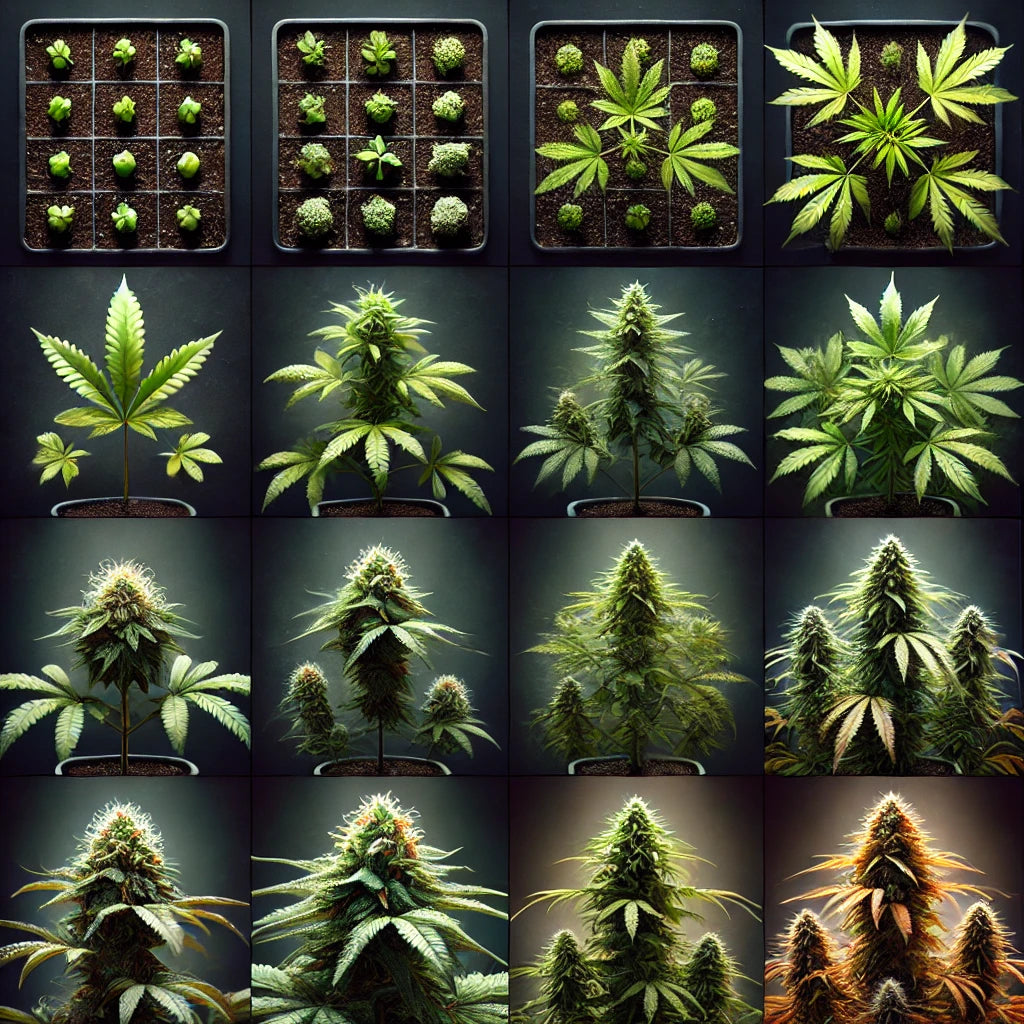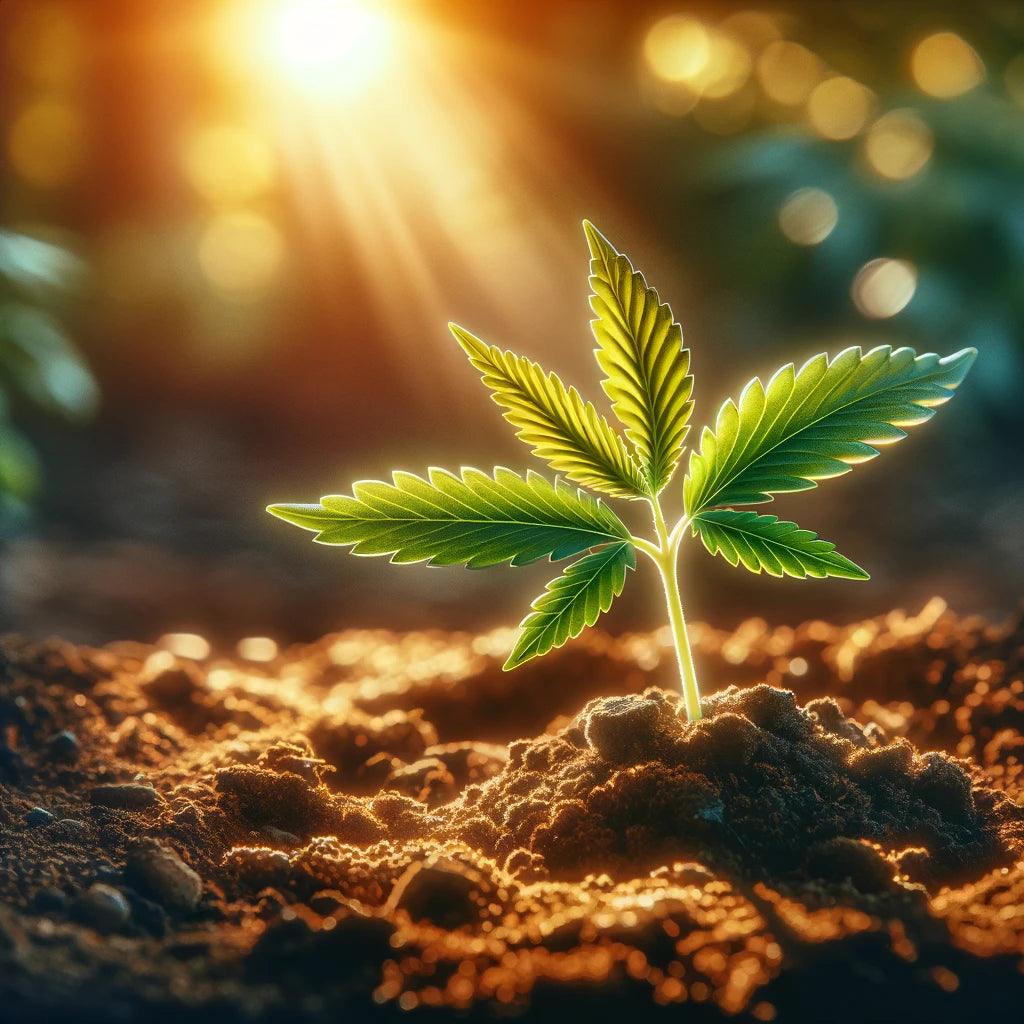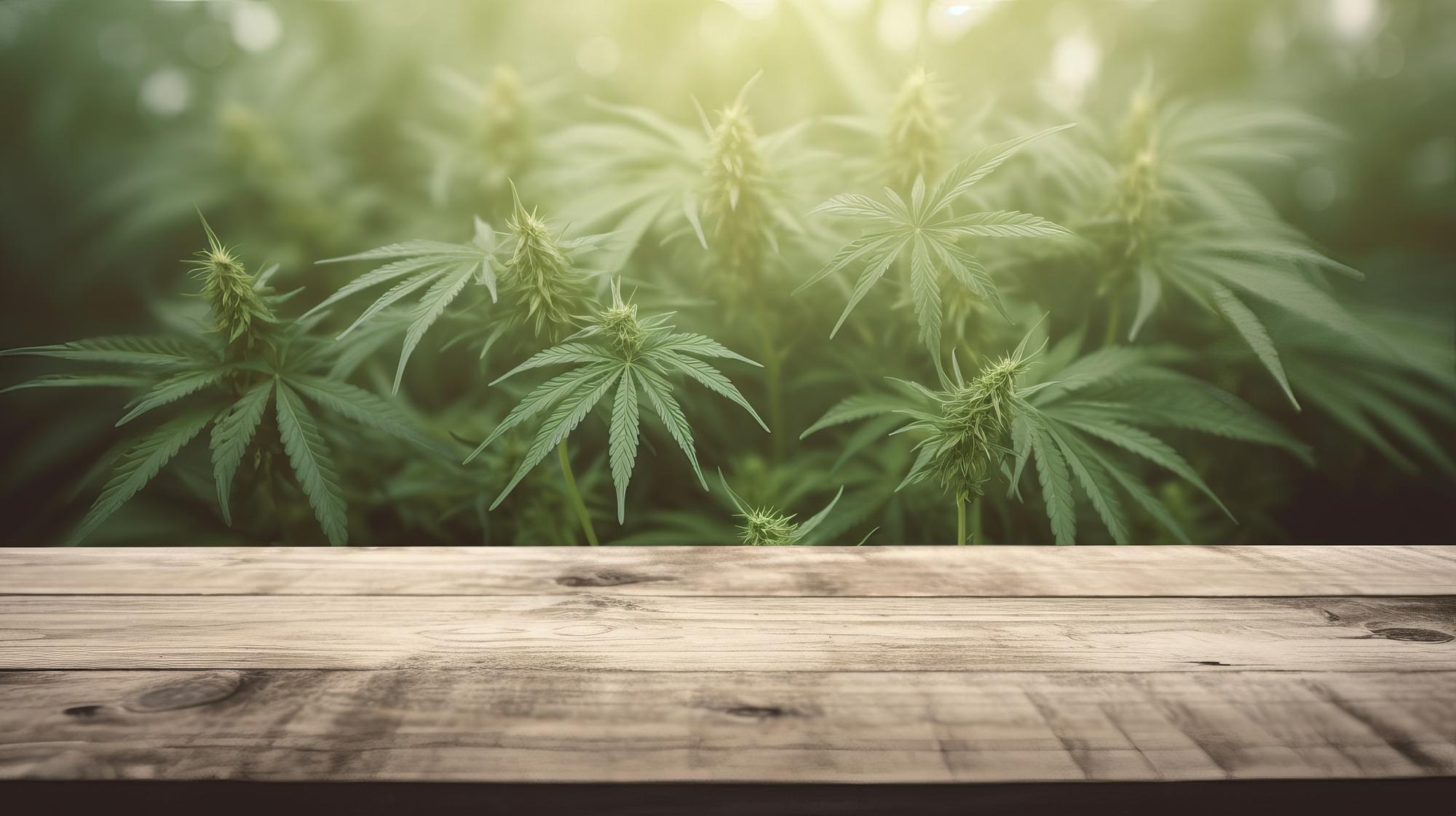1. Watchlist: Important steps at a glance
A concise overview of the key actions provides a solid foundation for a successful start to the seedling phase. This guide is designed to help growers keep track of the essential steps necessary for the optimal care and growth of their young cannabis plants.
1.1 Quick overview of key actions for the seedling phase
- Selecting the right cannabis strains based on growing environment and personal preferences.
- Choosing the right growing medium and appropriate containers to support root growth.
- Use of proven germination techniques to ensure a high success rate.
- Precise watering to avoid over- and underwatering and promote healthy root development.
- Optimal adjustment of light, temperature and humidity to support the growth of seedlings.
- Proactively manage nutrients to prevent deficiencies or excesses and grow robust plants.
- Prevention and control of diseases and pests to protect young plants.
2. Introduction to the seedling phase
The seedling stage is a crucial period in the life cycle of a cannabis plant, marking the transition from a newly germinated seed to a young plant. During this stage, the seedling lays the foundation for its future growth and productivity. Correct handling and care during this early stage can significantly affect the success of the entire cultivation. This section introduces the basics of the seedling stage, explains its importance, and outlines the key developmental steps that can be observed during this critical period. Understanding and paying attention to the needs of young cannabis plants during this stage is crucial to promoting healthy and vigorous growth.
2.1 Importance of the seedling phase
The seedling stage is more than just the beginning of a cannabis plant's life cycle; it's a time when the course is set for the plant's health, strength, and yield. During this stage, the seedling develops its first leaves and roots, which are essential for absorbing light and nutrients. A stable and supportive environment during this stage is crucial, as young plants can be particularly sensitive to stressors such as inappropriate watering, incorrect lighting conditions, or pest infestations. A successful passage through the seedling stage lays the foundation for robust growth in the later stages and maximizes the plant's potential to produce high yields and quality flowers.
2.2 Overview of development steps
The development of a cannabis seedling goes through several key phases, starting with the germination of the seed and ending with the formation of the first true leaves. After successful germination, during which the root (radicle) and shoot (hypocotyl) emerge from the seed, the seedling begins to grow its first leaves, called cotyledons. These are crucial for the initial photosynthesis and energy supply of the young plant. The first true cannabis leaves then develop, which have typical serrated features. During this phase, the seedling also begins to actively develop its root system, which forms an important basis for water absorption and nutrient supply. Carefully observing and supporting these developmental steps is crucial to accompany the young plants on their way to healthy vegetative growth.
3. Make the right choice
Success in the seedling stage and beyond begins with making the right choices - from the genetics of the seeds to the growing materials. These decisions affect not only the viability of the young plants, but also their ability to thrive in the given growing conditions and ultimately the quality and quantity of the harvest. Selecting the right cannabis strain, considering the specific needs of that strain, and choosing the appropriate growing medium and containers are crucial steps that should be carefully planned. This section is devoted to strategic planning and offers valuable insight into how to make the optimal decisions to lay a solid foundation for cannabis cultivation success.
3.1 Choosing genetics for your seedlings
Choosing the right genetics is crucial to the success of your cannabis plants. Different strains not only bring different drug profiles and yield potential, but also specific requirements for their environment. Autoflowering strains, for example, are known for their easy care and fast growth cycles, while photoperiod strains often produce higher yields and require precise control of the light cycle. CBD-rich strains offer therapeutic benefits without strong psychoactive effects, making them particularly attractive to medical users. When choosing genetics, you should consider not only your personal preferences, but also the growing environment, your experience as a grower, and the specific needs of the plant to ensure that your cannabis seedlings have the potential to fully develop.
3.2 Choose suitable containers and growing medium
The choice of growing medium and containers is another critical decision that will significantly affect the development of young cannabis plants. A suitable growing medium should provide a balanced mix of aeration and water-holding capacity to support healthy root growth and effective nutrient uptake. Soil, coco coir or hydroponic systems offer different benefits and requirements that should be weighed up depending on your level of experience and growing environment.
The size and type of containers also play a crucial role. Pots that are too small can restrict root growth and lead to water shortages, while pots that are too large can increase the risk of overwatering. Fabric pots and air pots promote healthy root growth through their increased aeration, but may require more frequent watering. Choosing the right containers and growing medium will lay the foundation for seedlings to thrive and contribute to successful cannabis cultivation.
4. Use germination techniques
Successfully germinating cannabis seeds is the first step to growing healthy plants. This process requires careful attention and the application of specific techniques to create the best starting conditions for the seeds. Different germination methods offer different benefits and can be adapted depending on the specific conditions and preferences of the grower. From the traditional water glass method to the use of special starter kits, each technique aims to provide a moist and warm environment that encourages the seed to germinate. In this section, we will look at proven germination techniques that will help maximize germination success and lay a strong foundation for the continued growth of the cannabis plants.
4.1 Proven methods for seed germination
Germination of cannabis seeds can be done in a number of ways, each with its own advantages and disadvantages. Tried and tested methods include:
- Water glass method: This simple technique involves placing the seeds in a glass of water for 24 to 48 hours or until the seeds open and the root becomes visible. This method promotes water absorption and facilitates the germination process.
- Paper towel method: This method involves placing the seeds between damp paper towels and placing them in a dark room. The constant moisture and darkness encourage the seeds to germinate. It is important to check the moisture content of the paper towels regularly to avoid drying out.
- Direct seeding: Some growers prefer to plant the seeds directly into the growing medium. This method avoids transplant shock but requires careful moisture management to ensure the best germination conditions.
- Starter kits and propagation plugs: Special starter kits and propagation plugs provide a controlled environment for seed germination. They are often enriched with nutrients and provide the ideal balance of moisture and aeration for germination.
Regardless of the method chosen, it is crucial to carefully monitor the seeds during the germination process and keep conditions optimal. Successful germination is the cornerstone of healthy and vigorous cannabis plants.
4.2 Avoid mistakes that affect germination
During the germination process, mistakes can easily be made that negatively affect the development of the young cannabis plants. To maximize germination success, it is important to know and avoid common mistakes:
- Overwatering: Too much water can limit the oxygen supply to the seeds and increase the risk of mold growth. Balanced watering is crucial for healthy germination.
- Underwatering: Too little moisture will cause the seeds to dry out, preventing germination. Moisture conditions should be kept constant without drowning the seeds.
- Inappropriate temperatures: Temperatures that are too high or too low can affect germination. Ideally, temperatures should be between 20°C and 25°C to create optimal conditions.
- Using old or poorly stored seeds: The germination capacity of cannabis can decrease over time, especially if the seeds have been stored in poor conditions. Fresh, high-quality seeds from trusted sources increase the chances of successful germination.
- Sowing too deep: If seeds are planted too deep in the growing medium, it can be difficult for the seedling to reach the surface. A sowing depth of about 1-2 cm is usually optimal.
By avoiding these common mistakes, growers can lay the foundation for the healthy growth of their cannabis plants and pave the way for a successful growing season.
5. Optimize seedling care
After the seeds have successfully germinated, the young seedling enters a critical growth phase that requires careful care and attention. Seedling care includes proper watering, light supply, and temperature control to encourage strong and healthy growth. Optimized seedling care is crucial because young plants are particularly sensitive to environmental stress. Factors such as overwatering, inadequate lighting, or extreme temperature fluctuations can significantly affect seedling development. In this section, we will focus on how to create and maintain the ideal environment for the seedling phase to lay the foundation for successful and high-yielding cannabis cultivation.
5.1 Irrigation techniques for cannabis seedlings
Proper watering is crucial for the survival and healthy growth of cannabis seedlings. During this sensitive period, both overwatering and underwatering can cause serious problems. Here are some guidelines for effective watering techniques:
- Moderate watering: Seedlings require consistent but moderate moisture. Avoid standing water to minimize the risk of root rot.
- Using Spray Bottles: A fine spray bottle can help moisten the soil evenly without flooding the tender seedlings. This helps keep the top layer of soil moist without drowning the seedlings.
- Monitoring soil moisture: Check the soil moisture regularly by gently pressing your finger into the soil. If the top layer is dry, it is time for gentle watering.
- Adjust to growth: As the seedlings grow and their root system develops, the amount of watering can be gradually increased. Continue to be careful not to overwater the plants.
A balanced watering regime not only supports the development of a strong root system, but also promotes the overall health and vitality of young cannabis plants.
5.2 Adjust temperature and light conditions
The right temperature and sufficient light are crucial for the development of cannabis seedlings. These factors affect photosynthesis, root growth and the overall health of the young plants. Here are some tips to create optimal conditions for seedlings:
- Optimal temperature: Cannabis seedlings thrive best at a constant temperature between 20°C and 25°C. A temperature that is too high or too low can slow or even damage growth.
- Light intensity and duration: Seedlings need a lot of light to grow vigorously, but the intensity should be moderate to avoid over-stress. An 18/6 light cycle (18 hours light, 6 hours dark) is recommended for the seedling stage.
- Using fluorescent lamps: For young seedlings, fluorescent lamps or special growth LEDs are suitable, which have a lower heat output and can be placed close to the plants without burning them.
- Avoid direct sunlight: While natural sunlight is ideal for cannabis plants, young seedlings should be protected from direct sunlight to prevent dehydration and burns.
By carefully controlling temperature and light conditions, you can encourage healthy growth and development of your cannabis seedlings and give them the best start in life as a cannabis plant.
5.3 Nutrient management in the seedling phase
During the seedling stage, cannabis plants are particularly sensitive to nutrient imbalances. Careful nutrient management is crucial to give young plants a healthy start. Here are some guidelines to avoid nutrient problems and promote optimal growth:
- Use a mild nutrient mix: Start with a very diluted solution of special seedling or starter fertilizers to minimize the risk of nutrient burn. Follow the manufacturer's recommendations for young plants.
- Observe leaf health: The first signs of nutrient deficiencies or excesses often appear on the leaves. Yellow, discolored or deformed leaves can indicate a problem.
- Increase nutrients slowly: Increase nutrient levels gradually as plants grow and their needs increase. A sudden increase can do more harm than good.
- Pay attention to pH: The pH of the water and growing medium affects nutrient uptake. Keep the pH within the optimal range to ensure that plants can effectively absorb the nutrients they need.
- Avoid premature fertilization: Seedlings initially draw nutrients from their cotyledons and growing medium. Additional fertilization is often not necessary in the first few weeks.
Careful nutrient management helps protect tender seedlings and support healthy growth during this malleable phase of their development.
6. Overcoming challenges
While the seedling stage is rich in opportunities for healthy growth, it also brings its own challenges. Young cannabis plants are particularly susceptible to a number of problems, including diseases, pests, nutrient imbalances, and physical stressors such as improper watering or unsuitable light conditions. The ability to identify these challenges early and respond to them effectively can mean the difference between a successful harvest and disappointing losses. This section looks at common problems that can arise during the seedling stage and offers field-tested solutions to successfully overcome them and support young plants on their path to robust growth.
6.1 Preventing damping-off disease
Damping off, caused by a number of soil fungi, such as Pythium, Fusarium and Rhizoctonia, is a serious threat to young cannabis plants. This disease attacks the stem at the base of the seedling, which can cause the plant to wilt and eventually fall over. To prevent this dangerous disease, preventative measures are crucial:
- Sterile growing medium: Use a sterile growing medium to minimize the chance of infection from soil fungi. Sterile growing soils and media are available at specialty stores.
- Proper watering: Avoid overwatering as standing water creates an ideal environment for soil fungi to develop. Make sure the growing medium is well drained and allowed to dry slightly between waterings.
- Good ventilation: Ensure good air circulation around the seedlings to prevent the accumulation of moisture, which can promote fungal growth.
- Use of fungicides: In some cases, preventative use of biological or chemical fungicides can help prevent damping-off. Choose products that are safe for young plants.
By applying these preventative measures, you can protect your young cannabis plants and ensure healthy development during the critical seedling phase.
6.2 Combating diseases and pests
Controlling diseases and pests is another critical aspect of growing cannabis, especially during the vulnerable seedling stage. Early detection and treatment can prevent pests and diseases from spreading and causing serious damage. Here are some strategies to protect your seedlings:
- Regular monitoring: Check your seedlings daily for signs of pest infestation or disease symptoms. Early detection is crucial for successful control.
- Preventive measures: Keep your growing area clean and free of plant debris to avoid the development of diseases and pest nests. Use prophylactic agents such as neem oil or insect-repellent plants as natural prevention strategies.
- Appropriate treatment: If signs of infestation or disease appear, choose appropriate treatment methods that are safe for young plants. Organic pesticides and fungicides can be effective without harming seedlings.
- Optimize environmental conditions: Many pests and diseases thrive in certain environmental conditions. By optimizing temperature, humidity and air circulation, you can create a less inviting environment for pests and pathogens.
- Isolating new plants: Isolate new plants first to prevent them from introducing pests or diseases into your growing area.
Through preventative measures and careful care, you can ensure that your seedlings grow healthy and develop into strong, resilient plants.
6.3 Avoiding stretching seedlings
Stretching seedlings can be a sign of suboptimal growing conditions, especially in terms of light. When seedlings don't get enough light, they stretch toward the light source, resulting in weak and elongated plants. To encourage healthy growth and avoid stretching, here are some effective measures:
- Adequate light: Make sure your seedlings get enough light. Use grow lights designed for indoor cultivation and place them at the right distance from the plants to ensure optimal light supply without overheating.
- Correct light spectrum: Seedlings benefit from light in the blue spectrum, which promotes compact growth. Many grow lights offer specific spectra suitable for the seedling stage.
- Adjust light cycle: A light cycle of 18 hours of light and 6 hours of darkness is often recommended for seedlings to support their growth and health.
- Rotating the plants: When working with natural light sources, rotate the plants regularly to ensure that they grow evenly and do not stretch in one direction.
- Adjust the height of the light source: Adjust the height of the light source to ensure that the seedlings do not have to stretch for light. Positioning the light source too high will encourage stretching, while positioning it too low could burn the leaves.
By following these tips, you can encourage strong and healthy growth of your cannabis seedlings and minimize the risk of stretching.
7. Growth and repotting
After seedlings successfully navigate their first few weeks of life, they enter a period of increased growth, which often requires transplanting. Transplanting is a crucial step to provide growing plants with more room to develop their roots and improve access to fresh nutrients. This phase requires careful planning and execution to minimize stress on plants and support their continued healthy growth. Performing transplanting in a timely and proper manner can promote root growth, improve nutrient uptake, and ultimately result in stronger plants with higher yield potential. In this section, we will discuss the key aspects of growing and transplanting young cannabis plants to provide growers with the information and techniques they need to make this important transition.
7.1 When and how to repot seedlings
Repotting cannabis seedlings is a critical step that should be done at the right time and in the right way so as not to hinder growth. Here are some tips to help you make this process successful:
- Knowing when to repot: A good indicator of when it's right to repot is the growth of the plant. When the seedlings have developed two to three sets of true leaves, or when the roots fill the current pot and grow out the bottom, it's time to think about repotting.
- Preparing the new pot: Choose a pot large enough to support the next few weeks of growth, typically a pot at least twice the size of the current one. Make sure the pot has good drainage to avoid waterlogging.
- Gentle repotting: Care must be taken when repotting so as not to damage the delicate roots. Gently loosen the soil around the edge of the pot and lift the plant out with some of the surrounding soil to keep the root ball as intact as possible.
- Adjusting watering: After repotting, plants need appropriate watering to reduce stress and help them adjust to the new pot. However, avoid overwatering as this can affect root growth.
Careful repotting not only supports the immediate growth of the cannabis plant, but also lays a healthy foundation for development in the coming months.
7.2 Techniques to promote healthy growth
After successfully transplanting cannabis seedlings, it is important to use techniques that encourage healthy and vigorous growth. These techniques will help plants reach their full potential and contribute to a successful growing cycle:
- Adequate lighting: Make sure plants receive adequate light, especially after repotting. The right light intensity promotes photosynthesis and supports vigorous growth.
- Regular nutrient supply: After the plants have been repotted in fresh soil, gradually begin adding nutrients, adjusted to the plants' growth stage. A balanced nutrient supply is crucial for the development of strong, healthy plants.
- Control environmental conditions: Optimize environmental conditions, including temperature, humidity and air circulation, to create ideal growing conditions. Controlling these factors will help minimize stress to plants and prevent disease.
- Pruning and training: Techniques such as pruning or applying training methods such as LST (Low Stress Training) can improve plant structure and increase light penetration, resulting in higher flower production.
- Monitor root growth: A healthy root system is fundamental to the growth of the plant. Make sure the roots have enough room to expand and are not restricted by pots that are too small or poor soil conditions.
By applying these techniques, you can create an optimal growing environment for your cannabis plants and lay the foundation for a successful flowering phase and harvest.
8. Deeper understanding of the seedling stage
The seedling stage is more than just a transitional phase in the life of a cannabis plant; it is a fundamental period that significantly influences the future growth and health of the plant. A thorough understanding of this stage allows growers to precisely control conditions and lay the foundation for successful cultivation. In this section, we will deepen our knowledge of the biological and environmental factors that play a role during the seedling stage. We will examine how different cannabis strains respond to different growing conditions and what specific needs must be considered during this critical growth phase. The goal is to give growers the tools they need to optimally support their young plants and pave the way for healthy, strong and productive cannabis plants.
8.1 Understanding the seedling phase
To effectively manage the seedling phase, a basic understanding of the biological processes that take place during this time is essential. During the seedling phase, the cannabis plant develops its first true leaves, which have the characteristic jagged appearance in contrast to the rounder cotyledons. These leaves are crucial for photosynthesis and therefore for the growth and development of the plant.
Another important aspect is the development of the root system. In the first few weeks, growth is largely focused on the roots, which spread and anchor to draw water and nutrients from the soil. A strong root system is the basis for a healthy and robust plant.
The seedling phase is also a time when plants are particularly vulnerable to stress and disease. Young cannabis plants have not yet developed resistance to external stressors such as temperature fluctuations, pests or incorrect watering. Therefore, it is crucial to create a stable and controlled environment that meets the specific needs of the young plants.
By having a deep understanding of this stage, growers can take proactive steps to protect and nurture their seedlings, laying the foundation for future growth and a successful harvest.
8.2 Special considerations for different cannabis strains
The response of cannabis seedlings to their environment can vary greatly depending on the genetic makeup of the particular strain. A thorough understanding of the specific requirements of different cannabis strains is crucial to ensuring optimal growing conditions during the seedling phase. Here are some important considerations:
- Autoflowering vs. Photoperiod Strains: Autoflowering strains start flowering automatically after a set period of time, regardless of light exposure. They are generally straightforward and ideal for beginners. Photoperiod strains, on the other hand, respond to changes in the light cycle and require specific light conditions to transition from the vegetative to the flowering phase.
- Indica vs. Sativa: Indica-dominant strains tend to grow more compact and bushy, while sativa-dominant strains often grow taller and slimmer with longer internodes. These growth patterns affect space requirements and care during the seedling stage.
- Resistance to stress: Some strains are naturally more resilient to stress factors such as temperature changes or pests. Knowing these characteristics can help select the right strain for specific growing environments or experience levels.
- Climate adaptation: Certain varieties thrive better in specific climates or environmental conditions. It is important to select varieties that are well adapted to local growing conditions to minimize stress and maximize growth potential.
By paying special attention to the selection of strains and their specific requirements during the seedling phase, growers can lay the foundation for healthy, vigorous plants and maximize the success of their cannabis cultivation.
9. Advanced Growing Tips
After mastering the basics of seedling care and transplanting, growers can expand their knowledge and skills with advanced techniques to maximize the growth and yields of their cannabis plants. These advanced tips include methods for optimizing environmental conditions, applying specific training and pruning techniques, and effective pest and disease control. They aim to give plants the best possible conditions for healthy growth while increasing the potential for higher yields and quality flowers. In this section, we'll share some of these advanced growing tips, designed for both experienced growers and ambitious beginners looking to take their growing skills to the next level.
9.1 Use of growth stimulants
Growth stimulants can be a valuable addition to cannabis cultivation by promoting plant development and health. These products range from organic to chemical additives and offer various benefits, from improving root formation to increasing flower production. Here are some tips for using growth stimulants effectively:
- Root stimulants: Special root stimulants can promote root growth by stimulating the formation of new roots and improving nutrient uptake. Application in the early growth stages can result in stronger and healthier plants.
- Biostimulants: Natural biostimulants, such as seaweed extracts or humic acids, can support plant health by promoting beneficial microorganisms in the soil and improving stress resistance.
- Foliar application: Some stimulants can be applied directly to the leaves to improve photosynthesis and quickly correct nutrient deficiencies, but this method should be used with caution to avoid overstressing the plants.
- Follow manufacturer's instructions: It is important to follow the manufacturer's instructions carefully and dose the stimulants correctly to avoid negative effects on the plants.
Proper use of growth stimulants can make a significant difference in the growing cycle by supporting the health and growth of cannabis plants and leading to higher yields.
9.2 Use of innovative cultivation aids
In the ever-evolving world of cannabis cultivation, innovative growing tools are opening up new opportunities to optimize plant growth and increase yields. From automated irrigation systems to advanced LED grow lights, utilizing modern technology can provide a significant advantage. Here are some approaches to integrating innovative tools into your grow:
- Automated irrigation systems: These systems can help optimize the irrigation regime by delivering water exactly when the plants need it, minimizing the risk of over- and underwatering while saving time and effort.
- Full Spectrum LED Grow Lights: Advanced LED lights provide a full spectrum of light that mimics the natural sunlight cycle, which is critical for plant growth. Their energy efficiency and longevity make them a popular choice for indoor growers.
- Smart grow apps and systems: Technological solutions that allow growers to remotely monitor and adjust growing conditions offer unprecedented control. From monitoring pH to adjusting lighting, these tools can help ensure an optimal growing environment.
- CO 2 enrichment systems: Increased CO 2 concentration in the growing environment can accelerate photosynthesis and plant growth, but these systems must be carefully managed to achieve the best results.
Investing in innovative cultivation tools can increase efficiency, simplify crop management and ultimately lead to healthier plants and higher yields.
10. Conclusions
The seedling stage is a crucial stage in a cannabis plant's life cycle that lays the foundation for future growth and cultivation success. By applying appropriate techniques and strategies, growers can promote the health and vigor of their young plants, which will ultimately be reflected in the quality and quantity of the harvest. This guide has highlighted the importance of choosing the right genetics and growing materials, provided practical tips for germination and transplanting, and presented advanced techniques for optimizing seedling care. By integrating these insights into their cultivation practices, growers will be well equipped to successfully cultivate their cannabis plants through the seedling stage and beyond. In conclusion, it is important to emphasize that continuous learning and adapting to the specific needs of the plants is crucial to mastering the art of cannabis cultivation and achieving outstanding results.
10.1 Summary of key points
To maximize success during the seedling phase and throughout the growing cycle, it is important to keep a few key points in mind:
- Genetic selection: Choosing the right variety according to growing conditions and personal preferences lays the foundation for success.
- Optimal germination conditions: Successful germination requires careful monitoring and application of proven methods to create the best basis for growth.
- Careful seedling care: Proper watering, light supply and temperature control are crucial to giving young plants a healthy start.
- Advanced cultivation techniques: The use of growth stimulants and innovative cultivation aids can further promote plant development and increase yields.
- Adaptability and observation: Successful cultivation requires continuous observation of plants and adapting care practices to their changing needs.
These key points provide a solid foundation for any grower to overcome the challenges of the seedling stage and pave the way for successful growth and bountiful harvests.
10.2 Motivation for successful cultivation
The art of growing cannabis is a journey that not only requires patience and dedication, but can also be a source of great satisfaction and fulfillment. Here are some motivating factors that can inspire and motivate any grower:
- Connection to nature: Caring for plants allows for a deeper connection to nature and its cycles, which is an enriching and grounding experience.
- Acquisition of knowledge: Each growing season provides opportunities for learning and experimentation, which contributes to personal development and the expansion of one's knowledge.
- Self-sufficiency: Growing your own cannabis plants for medical or personal purposes promotes independence and self-sufficiency, which is especially valuable in times of rising prices and market uncertainty.
- Community and exchange: Growing cannabis opens the door to a global community of like-minded people who share knowledge, experiences and support.
- Creative expression: Cultivation offers endless opportunities for creative expression, from selecting strains to designing the grow space and refining cultivation techniques.
Ultimately, it is the passion for cultivation that drives every grower to overcome challenges and experience the joy of harvesting the fruits of their labor. This motivation is the key to successful cultivation and continuous improvement to produce high-quality cannabis.

















